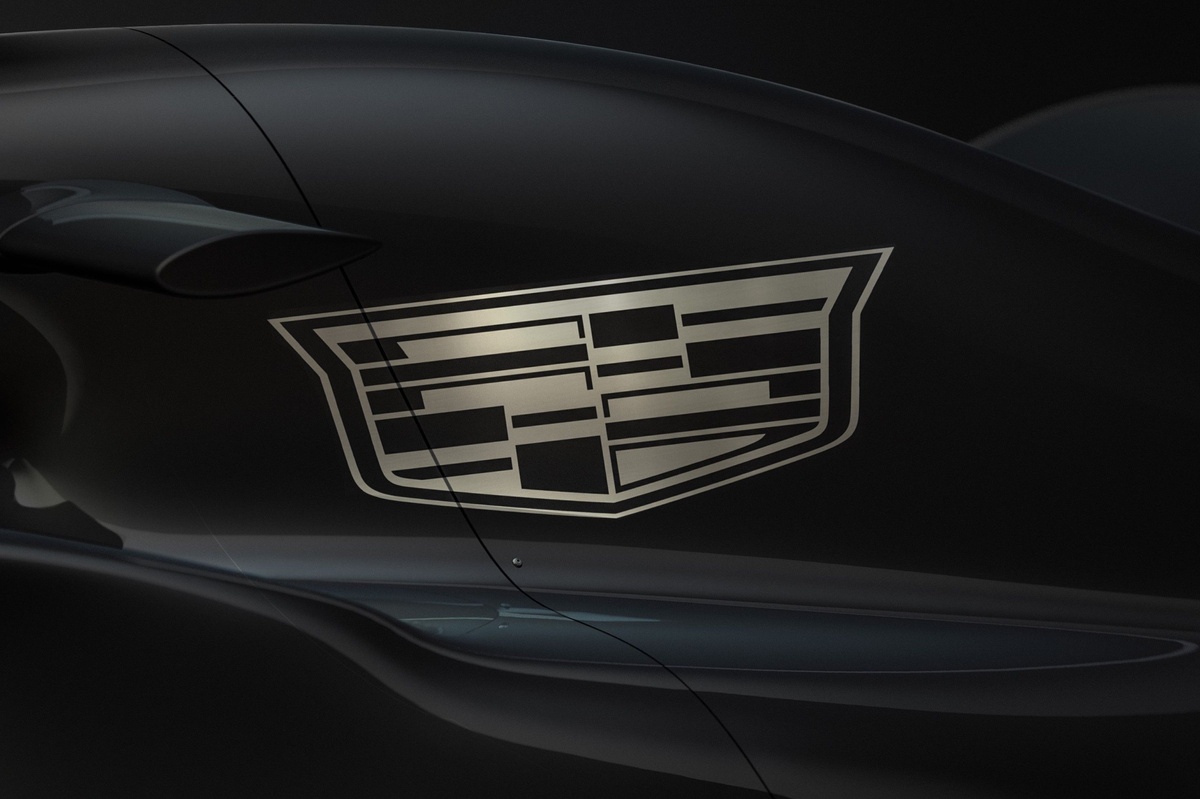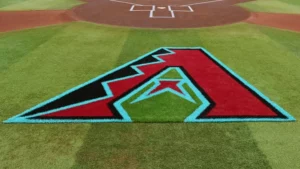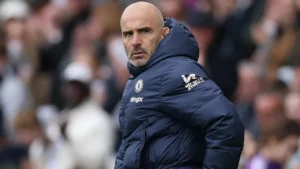Sometimes, Formula 1 needs a hint of acidity to cut through some of its more cloying elements; a little lemon sorbet, perhaps, or a raspberry coulis.
The addition of Cadillac to the grid in 2026 has partially offered that, although recent weeks have felt like one of the troughs in the many waves of information from the team. We know it’ll be running Ferrari powertrains until its own project is fully online, it has a base at Silverstone with plenty of ex-F1 personnel helming the ship, and comes with plenty of backing from owners TWG Global and General Motors.
What we don’t have is a driver line-up, a livery (or the known identity of any sponsors, beyond Tommy Hilfiger), and we won’t have a car until the 2026 prelude begins in earnest. Those facets will become evident over the next few months as the key deals start to roll in. There won’t be any shortage of interest, given GM’s involvement and its status as the pre-eminent American team; as much as Haas has tried to brand itself as such, it scarcely feels like one owing to its pan-European model of operations.
In any case, F1 history is steeped with lessons in how to (and how not to) go racing as an entirely new entity. The road will be long, arduous, and full of pitfalls along the way that can very easily ensnare the Cadillac squad. It may yet fall into some of them, and that’ll be part of the learning process. But it must be careful not to become too cocksure; pride comes before a fall, or some other trite statement will apply here.
We’ve chosen to focus our examples on the past 35 years, simply for brevity; there are countless examples of poor teams that cluttered the grid pre-1990 which, be it through lack of finance or simply lack of professionalism, left nothing more than the faded memory of glorious ineptitude upon the championship. We’ve also not included buyouts of existing teams, unless the successor effectively did so to claim the entry and abandoned the rest of the assets.
Here’s the manifesto of what Cadillac needs to succeed in its maiden F1 season.
Point 1: Attract strong, reliable drivers
Good examples: Sauber (1993), Stewart (1997), BAR (1999), Lotus Racing (2010)

Jan Magnussen, Rubens Barrichello, Stewart Grand Prix Ford SF-1
Photo by: Sutton Images
These were all teams that used their pulling power – and competitive salaries – to convince some of F1’s more experienced runners with a strong track record to lead the team. Sauber secured the services of JJ Lehto – who had two-and-a-bit seasons of F1 experience – to partner Mercedes protege Karl Wendlinger. Of the two, the Austrian had been able to shine the brightest, but Lehto did his part getting the team off the mark at its debut race at Kyalami.
Stewart Grand Prix managed to engage the services of Rubens Barrichello to partner Jan Magnussen; although Magnussen’s signing didn’t quite work out as planned, he came into F1 very highly rated following his blockbuster ’94 British F3 campaign – where he dominated the category more than Mika Hakkinen or Ayrton Senna ever had. It’s well known that Stewart had been in the frame to sign Damon Hill following the 1996 champion’s exit from Williams, but Hill felt it was too risky to sign for a start-up team.
His successor, Jacques Villeneuve, did just that with BAR to partner 1997 F3000 champion and 1998 FIA GT champion Ricardo Zonta. BAR’s debut year was not quite as conducive to success, but getting Villeneuve on board was a colossal coup; the Canadian even chose not to pursue potential openings at McLaren and Benetton to stick with BAR at the urging of team owner and manager Craig Pollock.
When Lotus “re-entered” the championship in 2010, it did so with the signatures of two F1 race winners in Heikki Kovalainen and Jarno Trulli. It was an impressive line-up, albeit one that was unable to score a point as Tony Fernandes’ outfit was unable to match the established teams. 2011 offered an uptick in form but, for 2012, Trulli was replaced at the 11th hour by Vitaly Petrov. Still, the Russian was a solid racer and brought much-needed capital as Fernandes sought to dilute his investment.
Bad examples: The second car of Super Aguri (2006), or Pacific (1994)
In the era of two drivers in a team, there are very few examples of genuinely poor line-ups in the two seats. Usually, teams have either been sensible enough to hire two experienced, steady hands to guide them through the first year, or partnered one veteran with a younger driver who either shows promise or a cheque bearing a healthy quantity of zeroes.
Let’s consider putting Pacific’s 1994 line-up on this list. Bertrand Gachot’s reputation as a solid (and moneyed) driver made him an eminently sensible pick for any newcomer team, but Paul Belmondo was purely there on the funds that he was funnelling to the team. After scoring just three points in five years racing in F3000, Belmondo – son of French film star Jean-Paul – ended up buying his way into the moribund March team for the first 11 races 1992 season, and was desperately slow. After departing, he washed up at Pacific in 1994 alongside Gachot.

Bertrand Gachot and Paul Belmondo in the Pacific garage.
Photo by: LAT Photographic
The ex-F3000 team’s first F1 car was dreadful, but Gachot at least made the grid on five occasions; Belmondo did so for two races, albeit helped a) by Sauber’s withdrawal from Monaco after Karl Wendlinger’s horror crash, and b) Andrea Montermini’s weekend-ending shunt at Barcelona.
Super Aguri had a similar situation, in that it paired an F1 cult hero (and future two-time Indy 500) in Takuma Sato with a relative unknown in Yuji Ide. Created effectively as a soft landing pad for Sato after being jettisoned from Honda, Super Aguri wanted to prioritise Japanese talent for the second seat. As he’d known Aguri Suzuki for years and had strong Formula Nippon results, Ide was signed – but did not mesh at all with the UK-based engineers working from Arrows’ former base at Leafield. After four races, defined by his chasm-like gap to Sato and Imola shunt with Christijan Albers, Ide had his superlicence revoked. Franck Montagny took the drive for a few rounds, before Yamamoto completed the year.
Point 2: Get the right partners
Good examples: Stewart (1997), Toyota (2002)
Thanks to his time working with some of the world’s biggest brands after his F1 career, Jackie Stewart had a Rolodex of contact details for the CEOs of the most reputable companies worldwide. Firstly, his decision to tap up Ford for works support helped to get Stewart off the ground; next, he managed to convince HSBC chairman Sir Willie Purves to pitch a sponsorship deal to the bank’s board. Texaco, Sanyo, and Malaysia’s tourist board all signed up for Stewart’s first year to ensure the team’s budget was comparable to those in the upper midfield.
Toyota was underwriting its own F1 project at great expense, but it also managed to collect a series of massive brands to put their name to the white-and-red machines. Panasonic paid for title sponsorship, in a deal that lasted for Toyota’s entire stint in F1, while Esso, Wella, Travelex, and AOL Time Warner were also on board.
The clutch of blue-chip sponsors rather bucked the trends that new teams had followed through the late 1980s – largely, in selling a host of small livery spaces to industrialists rather than larger companies. While Jordan gathered the likes of PepsiCo and Fujifilm in 1991 for its first year, the outright value of these deals was not particularly huge – nor did they last beyond that first season.
Bad examples: Simtek (1994), Mastercard Lola (1997), Virgin Racing (2010), US F1 (2010)
The opening three examples here all followed very similar business models, in that a company claimed livery space under the proviso that they would make money from it and thus, the team would benefit. It allowed smaller teams to appear to have claimed huge sponsorship deals with massive brands but, actually, the money involved very rarely affected the bottom line for said companies. MTV Europe signed a deal with Simtek, F1’s newest entrant for 1994, and gave the team advertising space on its TV channels in lieu of sponsorship money; Simtek would then have to sell adverts to recoup that money. The team withdrew midway through 1995 with debts of $10m. Money for nothing? Hardly.

Lucas di Grassi and Timo Glock, Virgin Racing
Photo by: Sutton Images
Lola’s return to F1 as a constructor was not only hampered by a car that had never seen the inside of a wind tunnel, but financially crippled by Mastercard’s unwillingness to fund the team properly. Instead of forking out a lump sum, Mastercard created a special members’ club; any customer could become a member for a fee per year, get access to limited team memorabilia and, for the higher tiers, hospitality and exclusive events. Unfortunately, this never caught on – Lola went to Australia, failed to qualify, then rocked up in Brazil before electing not to race.
In 2010, Manor sold its title sponsorship rights to Virgin Group, under the proviso that Richard Branson’s empire would command the livery space and sell it to prospective sponsors – although there were few that wanted to put their money into a team that was stranded at the back of the F1 grid. As for prospective entrants US F1, it was originally said to have investment from YouTube co-founder Chad Hurley – but the American pulled his money from the team as it looked increasingly unlikely to join the grid.
Point 3: Build a reliable, competitive car
Good examples: Jordan (1991), Sauber (1993), Haas (2016)
Easier said than done, this – the reliable part will likely be sufficient. Cadillac has a host of ex-Renault personnel working on its cars, so there’s no shortage of expertise. Jordan’s 191 is held up as a paragon of what a new team can accomplish; Gary Anderson’s gorgeous green machine was designed to be simple and well-behaved – and as such, was putty in the hands of Gachot and Andrea de Cesaris. Getting a customer Ford HB deal was central to this, as the team was not saddled by the less-competitive DFR used by its pre-qualifying competitors.
Sauber did likewise with its Harvey Postlethwaite-penned chassis, another well-mannered car that made use of Ilmor’s Mercedes-backed V10. While early-season reliability was shaky, the car was at least competitive and raked in a total of 12 world championship points to outperform the likes of Footwork, Jordan, and Tyrrell.
And then there’s F1’s most recent example in Haas. Many suspected that the VF-16 was very closely related to Ferrari’s 2015 car, given the nature of Haas’ relationship with the Maranello team, and its surprising results out of the box did little to dispel the idea that Ferrari’s involvement was greater than first suggested. Romain Grosjean bagged sixth place on debut for the American squad, following that up with fifth in Bahrain. He managed just three more points finishes that year, but this was enough for eighth overall in the championship – an excellent return.
Bad examples: Life (1990), Pacific (1994), Forti (1995), Lola (1997) BAR (1999), Virgin/Lotus/HRT (2010)
There are countless examples in the ‘bad’ camp here, simply because it’s so much easier to kick off in F1 with a shortfall in performance. Life took its chassis from the abortive FIRST entry (described as “an interesting flowerpot” by designer Ricardo Divila) plonked a W12 engine in it of its own, and set a new low bar for terrible F1 entries.

Heikki Kovalainen, Lotus T127 Cosworth, Timo Glock, Virgin VR-01 Cosworth, Jarno Trulli, Lotus T127 Cosworth, Lucas di Grassi, Virgin VR-01 Cosworth, and Karun Chandhok, HRT F1 F110-02
Photo by: Steve Etherington / Motorsport Images
Pacific’s PR01 was colossally off the pace in 1994; although it’s said that the car shared DNA with Benetton’s B194 given that both were spun from a prototype Reynard design for the 1992 season, the PR01 could not be further removed in terms of performance. In the following season, Forti’s FG01 is said to have been an evolution of Fondmetal’s 1992 GR02, although the designer of the latter – Sergio Rinland – refuses to take any credit for the FG01’s design, and won’t talk about his brief stint at the Italian team.
The FG01 looked outdated when it first arrived on the scene: it was bulky, overweight, equipped with a manual gearbox, and did not follow the modern trends of using the overhead roll hoop as an air intake. It was updated through the year but remained slow; one driver assumed the team’s moniker was apt, simply because the yellow machines were lapped so frequently that ‘it was like there were 40 of them’. Lola’s T97/30 was based upon a 1995 prototype and was miles off making the 107% cut line for qualifying in Australia, and BAR’s 01 was quick, but desperately unreliable due to the team’s unfamiliarity with the harmonics of its Supertec engine.
Then there were the entries from 2010’s trio of new teams. Lotus was a late addition to the grid, and thus deliberately produced a safe and sensible design to ensure it could finish the majority of races. Virgin’s VR-01 was billed as having a unique all-CFD approach to its aerodynamics, which could be viewed as an excuse to save money on avoiding the use of wind tunnels. Hispania’s Dallara-designed F110 faced a fraught development process; the design was originally contracted by Campos, which wasn’t able to consistently pay the bills.
Karun Chandhok told Autosport in 2020 that the F110 was “a case of ‘what if?'”, as more updates were planned beyond the “launch spec” car used through 2010. “For Spain, they showed me the update they had in CFD,” he said. “They had the sidepods in the tunnel and, on the CFD [the update] was something like 60 points of downforce, it was going to be worth two-and-a-half, three seconds, which would have put us in Toro Rosso territory.”
Point 4: Create a harmonious team dynamic
Good example: Stewart (1997)
Part of the reason why Stewart was so successful in such a short space of time was thanks to Sir Jackie’s motivational ability – and perhaps that denotes why the team crumbled after he’d left a few months after transitioning to Jaguar. Having forged a career as a consultant for Ford, commentator on US television, and as team owner of Paul Stewart Racing in F3 and F3000, Stewart understood what it took to build a strong business from the ground up and, flanked by son Paul, sought to create a team in that image. The Stewarts understood that unity was needed to make the team work from the off.
This was done by meshing the staff who had already worked under the aegis of the Stewart family across the junior categories with those recruited from other F1 teams, creating a consistent Stewart feeling. Directors Dave Stubbs and Andy Miller were brought in from the PSR F3000 and F3 teams to help lead the team, and assisted with the production side as Stewart broke ground on its Milton Keynes facilities. Alan Jenkins, procured from Footwork, was brought in to head up the design team.

Jackie Stewart, Jan Magnussen, Stewart Grand Prix Ford
Photo by: Sutton Images
And, while reliability faltered in the first year thanks to the combustible works Ford V10s, Stewart kept progressing to the point where it was a genuine contender for podium positions by 1999. Having Stewart in charge conferred a certain degree of agility to the designers and the freedom to implement updates; when Ford took over, the engineers were restricted considerably by the corporate bloat and need for any expenses to be rubber-stamped by the bean-counters in Dearborn. Stewart had the formula right; Jaguar did not.
Bad example: Andrea Moda (1992)
If nothing else, Andrea Moda serves as a case study in how not to set up a team. We’re partially breaking one of the rules here, as the team came to exist as a buyout of Coloni, although the team was unable to successfully argue this point to FISA and had to pay the $50,000 entry bond on joining the championship.
One could do a whole piece on Andrea Moda alone but, for the purposes of being concise, we’ll simply use the example of how it treated driver Perry McCarthy. After Alex Caffi and Enrico Bertaggia left due to their non-participation in the opening two races, team owner Andrea Sassetti signed journeyman Roberto Moreno and F3000 racer Perry McCarthy – who had to beg, steal, and borrow (with the help of Bernie Ecclestone) to get his superlicence application through the door in Brazil.
And even when the Brit had done so, Sassetti encouraged the team to treat McCarthy as persona non grata – a legacy of Bertaggia having come back with more sponsorship money, but not able to drive as Andrea Moda had used up all of its driver changes.
McCarthy was left at a hostel in Barcelona before making his pre-qualifying debut at Spain (which lasted all of 18 metres before his Judd engine cut out), sent out on a dry track with wet tyres at Silverstone, not permitted to leave the garage for pre-qualifying in Hungary until 45 seconds before the session ended, and being kitted out with a broken steering system for Belgium – one that had been removed from Moreno’s car. The latter point almost produced a violent crash at Eau Rouge when it jammed – McCarthy just about kept the car under control.
In this article
Jake Boxall-Legge
Formula 1
Be the first to know and subscribe for real-time news email updates on these topics
Subscribe to news alerts






